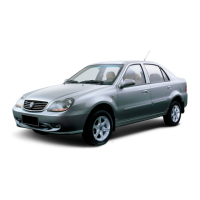221
Chapter 6 Audio System
Section 1 Audio System Description
Description:
1. Radio Wave Band
The radio wave bands used in radio broadcasting are as following:
LF: Low frequency
MF: Medium frequency
HF: High frequency
VHF: Very High frequency
2. Cover Area
There are great differences in the size of the
cover area for AM and FM monaural. Some-
times FM stereo broadcasts cannot be received
even though AM comes in very clearly. Not only
does FM stereo have the smallest cover area,
but it also picks up static and other types of in-
terference ("noise") easily.
3. Reception problems
Hint:
Besides the static noise fault, there are also the faults called "interference", "multipath transfer" and "fade
out". These faults are caused not by electrical noise but by the nature of the radio waves themselves.
(1) Interference
Besides static noise fault, AM broadcasts are
also susceptible to other types of noises, es-
pecially at night. This is because AM radio
waves are reflected by the Ionosphere at
night. These radio waves then interfere with
the signals from the same transmitter that
reach the vehicle's antenna directly. This type
of noise is called "interference".
Band LF MF HF VHF
Radio wave AM FM
Modulation
Frequency 30KHZ 300KHZ 3MHZ 30MHZ 300MHZ
Amplitude modulation Frequency modulation
FM (Stereo)
FM (Monaural)
Interference
Ionosphere

